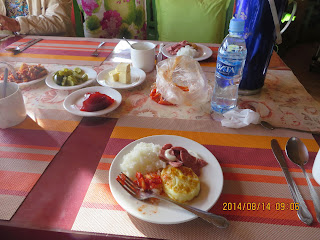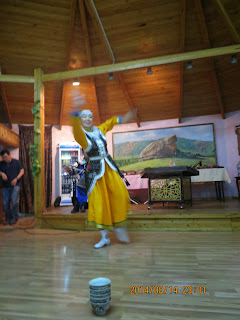140813 Mongolia Wild Life Experiences #4 “Rituals at the tabernacle” & “Performance of Mongolian traditional dance troupe"
Date: Aug. 14 (Thu) Fine
It was the last day (night) of the camp in Mongolia. It was a bit cold in the morning, but no additional woods in the stove.
We had “Heaven Support Exercise“ under the leadership of Pastor Lee from 7 am and had breakfast at 8 am. They provided Western style breakfast, but also Mongolian style milk tea. Some members provided “kimchi” from Korea. So, I also had rice with kimchi.
We had the last horse-riding session, and this time, all together, 50 participants rode on 50 horses at the same time.
My horse went on as one of the top group, as well as Mr. Giok Kim’s horse.
A pretty young lady who is studying Master Course at a theological seminary in Chicago, was also in the top group. So we could talk each other while we were horse-riding.
Since this was my 3rd time to ride on horse, I could get used to it very much. I could make my horse trotting, stop, turn either way much easily. It was fun.
After horse-riding sesstion, we had “Healing Code” session undter the leadership of Pastor Lee. Then we had “self-introduction” by The Group of Number Six.
The most of the members in this group were couples. The first couple were in the business of “Health Food.” The second couple were missionaries to Uganda, Africa. They said that they suffered from malaria two times.
Then we had Bible Study Sessiion by Pastor Kim. The text was Revelation and he explained the four animals (Lion, Calf, Man, Eagle) as 4 gospes (Mathew, Mark, Luke and John).
So Jesus as the king (Lion), Jesus as the sacrifice (Calf), Jesus as a man and Jesus as God.
We also learned the structure of Tabernacle and the meaning of Jesus washing diciples feet, etc.
After lunch, we got together in front of “Tabernacle” at the parking lot. It was a small size of “Tabernacle” which a disciple of the Korean missionary to Mongolia, built for us.
Pastor Kim explained the structure of “Tabernacle” and how the Jews performed the rites in the wilderness.
The Korean missionary introduced his Mongolian disciple, Odogoo to me because he married a Japanese.
He was born in 1968 and married a Japanese lady who was born in Tsuchiura. He goes to a theminary in Mongolia and will be a pastor in Mongolia in the future.
He is a father of two kids. He said he would come to Japan with his family next summer. I hope I can see him and his family in Japan next year.
After the study of “Tabernacle” we went out to the field trekking. We separated ourselves into two groups; one climbing to the mountain, and other, just walking around the camp site.
I went to the mountain, of course, with about a dozen of people. Pastor Lee led the group. We walked toward the pass to “Turtle Rock” then went toward the mountain.
We went up to the point of great view from which we could look down the field. Some trees were standing dead, but the view was great.
We did not go further, but returned from that point. When we returned to the base camp, it was 5:50 pm.
We had the last dinner in the camp. We ate “Baozi” and something like “Jiaozi” for dinner.
http://en.wikipedia.org/wiki/Baozi
http://en.wikipedia.org/wiki/Jiaozi
After the dinner, we had “Healing Code” and Bible Study.
The theme of the study was “Prayer” from Luke 11. Pastor Kim called the chapter as “Chapter of Prayer.”
He analyzed “Lord’s Prayer” as 3 prayers concerning the heaven (Lord): 1) Hollowed be your name, 2) Your kingdom come, 3) Your will be done on earth, as it is in heaven, then concerning to man, 1) Food, 2) forgiveness to each other, 3) Free from trial and evil.
The three points concerning to prayer: 1) Prayer is custom, 2) Listening to God is more important to speaking your wishes, 3) Concentration is important. We can learn about these things from Luke 11.
Simple prayer is also important for practice. It is recommendable to repeat “Lord’s Prayer” and more simply, “Lord, please have pity on me.”
After the Bible Study session, we had Lord’s Supper ceremony. They used bread and “real” wine for the ceremony.
In the evening, after the Bible Study and Lord’s Supper ceremony, we enjoyed special performance by a Mongolian group named “Rhythm of Heaven” which consisted of 4 men and 2 women (A singer and a dancer).
They played the traditional Mongolian musical instruments and the songs and dance performance were also good.
I especially like the acrobatic dance performance with dishes on her head. To my surprise, there was milk in the container on her head. She poured the milk into the dish after dancing.
The songs reminded me of Japanese folk songs and Korean “Pansori” songs. They played Western music such as “‘O sole mio” and “Hungarian Dances.”
The man playing the flute-like musical instrument tooted with a long breath and it surprised the audience very much.
They go around the world for their performance, therefore, all of them spoke good English. Their performance ended at 10:40 pm.
----------------------------------------------------------------------------------------------------
分類:旅行、モンゴル「荒野の体験」#4
トピック:「幕屋の儀式」とモンゴル伝統舞踊団「天のリズム」の公演
年月日:2014年8月14日、晴れ
いよいよ最後の行事の日である。朝はかなり寒かったが、暖炉の追加のサービスはなかった。しかしよく寝て、トイレは明け方に一回起きたのみ。
7時からは明完牧師の指導で天助運動。8時からは朝食で、卵スープもうまかったが、食後のモンゴル式ミルクティーもうまかった。
ご飯は前日、基玉さんが残しておいたキムチでいただいた。パンもおいしくて、卵焼きやソーセージをはさんで食べた。
9時からは全員(50人)で乗馬。今回の馬は出発するまではちゃんと歩くか不安だったが歩き出したら常に先頭グループで、左右と停止、急ぎ足まで素直に言うことをきく馬だった。
基玉さんの馬も常に先頭を行き、今回は彼の写真を撮ることができた。
牧師の娘でシカゴの神学校、修士課程を修学中の小柄なアガシの馬も往路は同じペースだったので話ができた。
最後の乗馬はさすがに3回目なのでだいぶ慣れた気がする。急ぎ足と静止、左右ができれば車よりずっとやさしい。乗馬は1時間で最初の日と同じコースだった。
11時からは明完牧師によるヒーリングコードのもう一度詳しい説明と実践の後、最後の6組の自己紹介だった。
6組も夫婦が多く、最初の夫婦は健康食品の事業、2番目の夫婦はアフリカ・ウガンダの宣教師で、マラリアに2回罹るなど、悪戦苦闘中。他は一人で参加した女性が多かった。
聖書の講義は聖所・聖幕を中心に金牧師が話をされた。ヨハネ黙示録4:6に出てくる4つの生き物:獅子、子牛、人間、黒ハゲワシは4つの福音書:マタイ、マルコ、ルカ、ヨハネをあらわす。
すなわち王としてのイエス、犠牲としてのイエス、人間としてのイエス、神としてのイエスを象徴する生き物である。
聖所・聖幕の構造の説明とマタイに出てくる足を洗うイエスに対するペテロの愚問とそれに対するイエスの答えの意味と聖所の構造、その意味などを学んだ。
昼食後は、全員で駐車場の前の建造物の前に集合した。この建造物こそ、モンゴル宣教師の指導で神学校の一番弟子、オドゴーが兄と一緒に建設した、現物の3分の1の聖所だった。
この構造と意味の説明を金鎭洪牧師が3回に分けて説明した。また、この間に宣教師がオドゴーを私に紹介してくれたので話ができた。
彼は68年生れで、10年前に茨城県土浦出身の日本女性と結婚し、現在、モンゴルの神学生であり、将来牧師になると思われる。
二人の息子がいるそうで、ベースキャンプのまわりで遊んでいる男の子がそうなのかもしれない。来年の夏に家族を伴って来日するというので、そのときまた会えると楽しいことだ。
聖所の説明を聞いた後は4時からトレッキングだが、明完牧師はベースキャンプから見える揺れる岩の山に登ると言い、自信のないものは近所のトレッキングをするように、2グループに分けた。
登山組は15人で当然私も明完牧師についていった。コースは初日の亀岩へ向かったときの峠で、亀岩へ下らず、左折して山に向かった。
途中の断崖絶壁の上に馬が数頭、牧草を食んでいる姿がかっこよかった。しかし、実際には揺れる岩までは登山せず、展望台のところで写真を撮ってから引き返した。
ベースキャンプへ戻った時間は5時50分。食堂の入り口には乗馬のときに女性のカメラマンが取った写真が重量感のある枠に入って12000Wで売られていた。
最後の夕食は、モンゴル伝統のパオツ(包子)と焼き餃子のようなものだった。隣の姉妹は1つの食事を二人で食べるから毎回50%である。これは立派なダイエットだ。また、妹のほうは肉を食べないようだった。
夕食後、最後のヒーリングコードの指導と実践。その後、直ちに最後の聖書講座。
今回の課題は「祈祷」で、ルカ11章を「祈りの章」ということから始まった。主の祈祷の最初の3つは天にかかわる3祈祷①御名があがめられます様に、②御国が来ますように、③御心が天で行われるように地でも行われますように、続く3つは人にかかわる3祈祷①必要な食糧が与えられますように、②我々が罪を許しますから我々の罪も許してください、③我々を試みに会わせず、悪から守ってください、である。
祈りの3要点は:①祈りは習慣である。②祈りは自分の希望を述べるのではなく、神の御心を聞くことが肝要だ、③祈りは集中することが肝要である。これらのことがルカ11章に要約されている。
また、祈りに熟練するにはシンプルな祈りを繰り返すことである。主の祈りを繰り返すことも重要であるが、もっともシンプルな祈りは「主よ、私を哀れんでください。」である。
聖書の学びの後、賛美歌144番を歌って、パンとぶどう酒による「愛餐式」があった。
大きなパンを使い、皿に入れたぶどう酒に浸して口にする方法で、ダイナミックと言えばダイナミックである。
愛餐式のあと、モンゴルの楽団による公演があった。一団の名前は「天のリズム」、で男性楽手4人と女性の歌手1人と踊り子1人の6人で構成されている。
男性の楽器と声楽もすばらしく、また女性の歌唱力もすばらしい。ダンサーはアクロバティックで、圧巻は複数の食器を頭に載せて激しい動きのダンスの後、頭に載せた食器からミルクを注いで見せた場面だ。
歌は日本の民謡のようでもあり、韓国のパンソリのようでもあった。また、楽器の演奏は西洋音楽の演奏にも適していて、イタリア民謡のオー・ソレ・ミオ(私の太陽)やアンコールで演じたハンガリー舞曲もよかった。
オーソレ・ミオのクライマックスの長音の部分を笛で吹いたが一息で数分間続いた演奏にはおどろかされた。
世界各国を廻って公演しているだけあって、みな英語が達者である。英国エジンバラで長年暮らしたと言う女性の英語の質問に英語で答えていた。公演が終わったのは10時40分だった。
I like hiking very much. I used to go hiking with a Korean hiking club named “AhToSan.” This blog introduces mostly my hiking activities in Korea and Japan, and Sydney in Australia. As of January 2020, I live in Sydney suburb. I go Blue Mountains and bush walk in Sydney area. 私は2003年から2014年まで韓国の大田(テジョン)に住んだ日本人である。11年間、週末は主に「アトサン山岳会」に参加した。14年4月に帰国したが、2020年以降はおもにシドニーで暮らし、時折、日本へ帰国する程度である。したがって最近の記事はSR(Sydney Report)としてブルーマウンテンのトレッキングを中心に書いている。
About pictures/当ブログ内の写真について/당 블로그내의 사진에 대해서
Most of the pictures in this blog are taken by my camera, yet some of them were downloaded from the website of the hiking club. If you click any pictures, they become the original size.
当ブログ内の写真の大部分は筆者のカメラで撮影したものですが、一部、山岳会の共有写真からダウンロードしたものを含みます。すべて、各写真をクリックすれば、元のサイズに拡大します。
당 블로그내 사진의 대부분은 필자의 카메라로 촬영한 것입니다만 일부 산악회 공유 사진으로부터 다운한 것도 포함합니다. 모두 각 사진을 클릭하면, 원래 사이즈에 확대합니다.
当ブログ内の写真の大部分は筆者のカメラで撮影したものですが、一部、山岳会の共有写真からダウンロードしたものを含みます。すべて、各写真をクリックすれば、元のサイズに拡大します。
당 블로그내 사진의 대부분은 필자의 카메라로 촬영한 것입니다만 일부 산악회 공유 사진으로부터 다운한 것도 포함합니다. 모두 각 사진을 클릭하면, 원래 사이즈에 확대합니다.
登録:
コメントの投稿 (Atom)





























0 件のコメント:
コメントを投稿